東京から札幌へー From TOKYO to SAPPORO, HOKKAIDO(1960-1964年)
最初に飼った北海道犬は北海道の厚真町の中野さんから譲っていただいた。札幌に住んでまもなく犬好きの両親が北海道犬の話を聞いて、段取りが進み、叔母と私で中野さんのお宅に迎えに行った。厚真は札幌から約80キロ南下した日高寄りの町だった。札幌の北に位置する岩見沢、南の千歳、厚真、日高は、それぞれ特色ある素晴らしい北海道犬を、代々輩出してきた。中野さんのお宅の前には、父犬の厚王が悠然と寝そべっていた。私が会った初めての北海道犬だった。厚王の風格は、当時まだ中学生の私にも伝わり、見とれてしまった。厚王は全身ほぼ白の毛並だが、耳の淵はごく淡い茶があったように記憶している。厚王は札幌から来た私たちを歓迎もしなければ、不愛想でもなかった。厚王のそばで、白い子犬が歩き回っていたが、私たちが訪問して何か違う気配を感じたのか、動きをとめて様子を見ている。この子犬が伊智狼だった。
The first Hokkaido dog was given to us by Mr. Nakano from 厚真町(Atsuma Town), Hokkaido. Shortly after moving to Sapporo, my parents, who were dog lovers, heard about Hokkaido dogs, and set up the adoption process. Atsuma is a town near Hidaka, about 80 kilometers south of Sapporo. Iwamizawa (north of Sapporo), Chitose (south of Sapporo), Atsuma, and Hidaka have produced wonderful Hokkaido dogs with their own unique characteristics for generations. My aunt and I picked up the puppy at Mr. Nakano’s house. In front of Mr. Nakano’s house, Atsuo( 厚王), the father dog of the puppy, was lying calmly. It was the first Hokkaido dog I met. As a junior high school student, I was fascinated by Atsuo. Atsuo’s whole body was mostly covered with white coat, and I remember that the edges of his ears had a very light brown color. Atsuo was neither welcoming nor unfriendly to us, visitors from Sapporo. A white puppy was by Atsuo and it stopped moving when we visited as if he knew something was different. This puppy was Ichiro.
中野さんは、趣味が北海道犬で、中野犬舎の当時10歳ぐらいだった厚王の跡継ぎにと考えて、生後62日のかわいい盛りの子犬にすでに伊智狼という名前をつけていた。人に譲るのは気が進まなかったらしく、中野さんは口数が少なく寂しそうに見えた。これらはあとから私が振り返って想像したことで、かわいい子犬を早く家に連れて帰りたかった私は、中野さんの心情まではわからなかった。
Mr. Nakano had a hobby of raising Hokkaido dogs, and thought that the puppy would be the successor of Atsuo one day, who was already 10 years old at the time we visited the Nakano kennel, and had already named the cute 62 day-old puppy Ichiro. It seemed Mr. Nakano was reluctant to give away Ichiro. He seemed lonely and didn’t say much. I wanted to take the cute puppy home with us as soon as I could, but now that I look back, I feel I didn’t quite understand Mr. Nakano’s feelings.
両親、叔母、私と弟2人は伊智狼を前に飼っていた犬と同じように、ジョージと呼んだ。一所懸命かわいがり、運動(散歩)もさせたつもりだったのだが、1歳になる直前に病気で死んでしまった。その原因は何が悪かったのか、結局わからなかった。犬は初めてではなかったが、私たちにまだまだ犬を飼う知識や経験がなかったとしかいいようがない。家族全員で悲しんで、札幌雪まつりの大通り公園で一緒に撮った伊智狼の写真を眺めては泣いた。厚真の中野さんに申し訳ないとお詫びのしようもなかった。
My parents, aunt, my two younger brothers and I called Ichiro as George, which was the name we used to call the dog we kept before. We intended to make Ichiro do a lot of exercise (walking), but he died of illness immediately before he was one year old. We didn’t know what the cause was. Ichiro wasn’t our first dog, but we can only say that we didn’t have the knowledge or experience to keep a dog. The whole family was sad and cried when they saw the picture of Ichiro taken together at the Sapporo Snow Festival at Odori Park. My parents undoubtedly informed Mr. Nakano about Ichiro with a heartfelt apology, although I couldn’t apologize to him in person.

札幌雪祭り 1961年 ; 市民の手作りだった雪像
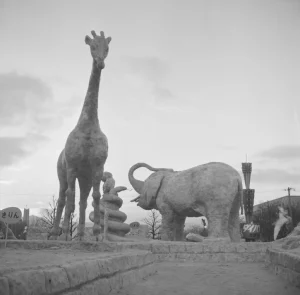
Sapporo snow festival 1961年 ; snow statues built by citizens of Sapporo

最初の伊智狼と With first Iciro from Atsuma(厚真),札幌大通公園で。左は叔母、後ろは中学生の筆者、from left, my aunt Tomie, the 1st Ichiro and me in junior high 1961年

左は母、右は叔母。雪祭りの札幌大通り公園で。1961年。left is my mother, right is aunt at snow festival, Sapporo Odori park .
天然記念物北海道犬保存会(道犬保 ー DoKenPo)
家族で悲しんだリ泣いたりしているうちに、半年後、両親に子犬を紹介してくださった方があったのか、家に生後54日という白い北海道犬の子犬が届いた。この子犬に血統書の名前は、前の伊智狼と同じ伊智狼と登録した。そして前の伊智狼と同じように、呼ぶ時はジョージと呼び、今度こそ、前の伊智狼のように、短命でかわいそうな目にあわせないようにしようと、北海道犬のことを知っている人たちからも話を聞きながら育て始めた。
Half a year later, while we were still overcoming the sadness, a white Hokkaido dog, 54-day old, arrived at my house. I think someone learned that my family had a Hokkaido dog pass away. We registered the name as Ichiro on the pedigree, same name as the Ichiro before. We also called him George. This time we were very careful so that the puppy wouldn’t have the same fate as the previous one. We listened to people who had knowledge and experience on how to keep Hokkaido dogs.
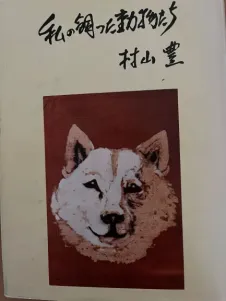
アイヌ犬が1937年、国の天然記念物に指定され、同時に犬の産地の名称から北海道犬と名付けられた。北海道犬保存会(道犬保)は、すでに1951年に設立され、村山豊氏(1902-1977年)が、会長をされていた。村山会長は、北海道大学農学部畜産学科を卒業し、農林省の種馬所長(種畜牧場)を北海道、秋田、鹿児島など日本全国で活躍された、馬の権威だった。
私は中学生だったので、村山会長とは直接お話を聞く機会はなかったが、両親と叔母の話から村山会長のお名前を頻繁に聞いた。同時に両親と叔母は、札幌にいた3年間、北海道大学の犬飼哲夫教授と元北海タイムス(現・北海道新聞)の記者で北海道犬保存会の伝法貫一氏とも親交があった。 犬飼先生と伝法さんは、伊智狼が家に来て間もなく、現在の札幌市中央区北1条通り(札樽国道と呼んでいた)沿いにあった我が家に立ち寄ってくださった。犬飼先生は、とりわけヒグマの研究で著名だった。ヒグマとアイヌの熊猟にアイヌ犬(注;北海道では、北海道犬はアイヌ犬と呼ばれてきた)が活躍してきたことから、北海道犬保存会も犬飼先生にご教示いただいていた。ヒグマというのは、日本では北海道にしかいない熊で、熊猟の写真や、また後に北大博物館で剥製を見たときには、その大きさには驚いた。2メートルを悠に超え、本州のツキノワグマとはスケールが違った。ただ私にとっては、犬も熊も同じ動物であり、かつて北海道では熊猟が、人間の生活を守るために必要だったとはいえ、狩猟そのものにはネガティブな関心を持った。しかし北海道犬は、熊猟に使えるかどうかが、大変重要な評価のポイントであることは理解できた。
従って、北海道犬としての総合的評価は、展覧会での容姿(体型、歩様、気質など)とともに、獣猟競技での狩猟本能(臭覚による追跡、熊に対面したときの態度など)があるかの成績も加味された。 北海道犬は次第に狩猟目的ではなく、家庭のペット 、すなわち 家族の一員として、飼育されるようになっていく。この時代の変化とともに北海道犬に、かつての狩猟性は求めないと考える人たちは、狩猟競技を行わない北海道犬協会という別の北海道犬愛好団体を設立して、北海道犬保存会(道犬保)を離れた。長い間、北海道犬の保存という点では、この2つの協会が主流であった。どちらの会も展覧会を実施して、よい犬を残していくという保存は重要であり、それは営利目的を優先することなく、北海道犬に魅せられた愛犬家たちの熱意によって支えられている。特に道犬保は、展覧会と獣猟競技の双方を実行し、北海道犬の保存に尽力してきたが、時代の推移とともに、会員の減少と財政難の危機は解決がなかなか困難であるようだ。国の認可を受けた法人への補助は多少あるとしても、会員と 限られた専門家集団が原則、ボランィテアで、北海道犬保存のために、系統別に「名犬」の子孫を繁殖してきた。その尽力には頭が下がる。
1960年代後半以降は、北海道地域だけでなく、全国で北海道犬を家族の一員として育てる愛犬家が増えた時代でもあった。北海道犬に関する専門家や経験や知識など交流し合う仲間も必要となり、道外(本州)に支部が増設されていった。
札幌で伊智狼を展覧会に出陳し、特に伊智狼にとって初めての展覧会、札幌雪祭りのなかで行われた北海道犬雪中展で特良一席をとったときは、家族で大喜びした。
ある時、北海道犬の保存活動で功績と人望があった林甲斐造先生とご子息が、展覧会での犬の写真の撮り方を教えてくださった。頭部や体躯全体をやや斜めから、犬の4つの脚がすべて見えるように撮る。犬は文字の描写だけではなく、写真や映像で伝えることが欠かせないと思った。その折、犬の写真の撮り方を教わりながら、中学生だった弟の岳義さんが撮った写真を、我が家ではずっと大切にしてきた。

1歳の伊智狼@札幌 大通り公園 Photo of Ichiro at the age of 1, taken by my brother Takeyoshi Yamano @ Oodori park, Sapporo
道犬保は、失敗談や自慢話を含めて、自分たちの経験や知識を交流し合って、情報を得られる貴重な場でもあった。伊智狼は、展覧会だけでなく獣猟競技に出陳すると、こちらは常に一席をとって熊猟の犬にしないかと、誘われた。アマチュアからプロの猟犬になる訓練を受ける話は、想像もできなかった。一番伊智狼を可愛がって、世話をしていた叔母は、無理だとわかりつつ、内心はとても光栄で大喜びしていた。私も同じ気持ちだった。
The Ainu dog was designated as Japan’s natural treasure in 1937, and at the same time, it was re-named as Hokkaido dog, using the name of the dog’s production area. The Hokkaido Dog Preservation Society was established in 1951, and Mr. Yutaka Murayama (1902-1977) was the chairman. Chairman Murayama graduated from the Department of Animal Husbandry, Faculty of Agriculture at Hokkaido University. He was also an authority on horses and was active throughout Japan, including Hokkaido, Akita, and Kagoshima, as the director of the breeding horse (breeding farm) of the Ministry of Agriculture and Forestry.
When I was a junior high school student, I didn’t have the opportunity to talk to Chairman Murayama, but I often heard his name from the stories of my parents and aunt. At the same time, my family had a connection with Professor Tetsuo Inukai of Hokkaido University and Mr. Kanichi Denpo, former journalist of the Hokkai Times (currently Hokkaido Shimbun), and member of the Hokkaido Dog Preservation Society. Shortly after Ichiro came to our house, Dr. Inukai and Denpo-san stopped by our house on North 1-jyo, West 15-chome, Sapporo City. Dr. Inukai was particularly well-known as a Brown bear scholar. Since Ainu dogs (note: In Hokkaido, Hokkaido dog had been called Ainu dog) had been hunting partners for Brown bear hunting, the Hokkaido Dog Preservation Society received lectures from Dr. Inukai. In Japan, brown bears are only found in Hokkaido. I was surprised at its huge size when I saw pictures of bear hunting and later stuffed animals at the Hokkaido University Museum. It was well over 2 meters, and the scale was different from that of the black bear in Honshu. However, for me, dogs and bears are the same animals, and although bear hunting was once necessary to protect human life in Hokkaido, hunting itself had a rather negative impression. Yet, I understand that whether Hokkaido dogs can be used for bear hunting is a very important point of evaluation.
Therefore, the overall evaluation to be considered as a Hokkaido dog includes the appearance at the exhibition (body shape, walking style, temperament, etc.) as well as its hunting instinct in the field trials (tracking by odor, attitude when facing a bear, etc.). These results were also taken into consideration. Hokkaido dogs are gradually being bred not for hunting purposes, but as domestic pets, that is, as members of the family. With these changes, those who think that Hokkaido dogs do not need to hunt established another Hokkaido dog lovers group called the Hokkaido Dog Association, which does not hold hunting competitions, and left the Hokkaido Dog Preservation Society (DoKenPo ). Even now, these two associations are the mainstream in terms of preserving Hokkaido dogs. It is important for both parties to hold exhibitions and preserve good dogs, which are supported by the enthusiasm of dog lovers who are fascinated by Hokkaido dogs, not for commercial purposes. In particular, DoKenPo has held both exhibitions and field trials and has made efforts to preserve Hokkaido dogs, but the decline in membership and the crisis of financial difficulties seem hard to resolve. A selected group of specialists have bred the offspring of “reputable dogs” by faction to preserve Hokkaido dogs with some income. I humbly respect their efforts. On the other hand, since the latter half of the 1960s, the number of dog lovers who raise Hokkaido dogs as a family member has increased not only in the Hokkaido area, but throughout the country. It was necessary to have experts on Hokkaido dogs and dog lovers to interact with each other, sharing experience and knowledge, and a branch was created outside Hokkaido.
Ichiro made an appearance at an exhibition. The exhibition was held during the Sapporo Snow Festival, which was the first exhibition for Ichiro to attend and he received the first prize. My family and I were overjoyed.
One day, Mr. Kaizo Hayashi, who is known and reputable for his contributions to preserve Hokkaido dogs, taught us with his son how to take good dog photos at an exhibition. He said we should take a picture of the entire head and body from a slight angle so that all four legs of the dog can be seen. I learned that it was essential to convey dogs not only with written descriptions, but also with photographs and videos. At that time, my younger brother Takeyoshi, who was a junior high school student, took great photos of Ichiro while we were being taught. In our family, we have always treasured the photo taken by my younger brother.
DoKenPo was also a valuable place to exchange information, experience and knowledge, including stories of failures and bragging rights. When Ichiro appeared not only in the exhibition, but also in the beast hunting competition, he always won awards and was asked to become a bear hunting dog. I was not in favor of having Ichiro become a professional hunting dog. My aunt who loved and took care of Ichiro the most was very honored and overjoyed, despite knowing that it was impossible to let Ichiro go through hard training for hunting. I shared the same feeling.
小山田さんのジロを訪ねて
道犬保 の柿崎先生と土屋先生は学校の教師をしておられたと記憶しているが、北海道の歴史に詳しく趣味が北海道犬だった。両氏はじめ会員の方々が伊智狼は、小山田さんのジロにとても似ていると言われたので、すでに展覧会でも獣猟競技でも名犬と言われていたジロを、小山田さんのお宅まで見に行った。伊智狼はジロのひ孫だった。私たちは5~6人でジロに会いにいって、犬舎の前で上からのぞき込むようにジロについて話をしている間、ジロは最初はちらりと私たちを見たが、あとは目をつぶり、時おり耳を動かし聞き耳をたてて、寝ていた。私は犬の狸寝入りを初めて見た。自分を見に来る訪問者に、うんざりしていたのかもしれない。私は厚真の中野さんのお宅の厚王を思い出した。厚王も歓迎も不快も示さず無言だった。ジロは毛並が淡赤(白に背や頭部などに一部にベージュが入っている)ではなく体全体が真っ白だった。その上、鼻は漆黒で爪も黒かった。それらは色素が後退していない証拠で、大変称賛されていた。
Visiting the Oyamadas and Giro
Mr. Kakizaki and Mr. Tsuchiya of Do Ken Po were schoolteachers who were familiar with the history of Hokkaido and had a common hobby which was Hokkaido dogs. Mr. Kakizaki, Mr.Tsuchiya and others said that Ichiro resembles Mr. Oyamada’s Hokkido dog, Giro, who was already a famous dog in both exhibitions and field trials. So, I went to see Giro with 5 or 6 people to Oyamada’s house. For Giro, Ichiro was his great-grandson. While we were talking about Giro in front of the kennel, looking into him from above, Giro glanced at us at first, but then he looked away. Giro closed his eyes as if he was sleeping, moving his ears from time to time. Perhaps he was fed up with the visitors who came to see him. Giro’s behavior reminded me of Nakano-san’s dog Atsuo who was the first Ichiro’s father. Atsuo was silent without showing any sign of welcome or discomfort when we visited Nakano’s house in Atsuma when we picked up his puppy. Giro’s coat was pure white. Besides, his nose was pitch black and his nails were as well. These characteristics were highly praised for evidence that the pigment had not receded.
北一条通り
私たちは、札幌市北一条通りに面した、知事公館という一角に住んでいた。北一条通りは、北原白秋作詩、山田耕筰作曲の「この道」で歌われている。「この道はいつか来た道 ああ そうだよ アカシアの花が咲いている。 あの丘はいつか見た丘 ああそうだよ ほら 白い時計台だよ」。1960年代のことで、現在の知事公館の様相とは異なっていた。北一条通りを背にして、左から町村金五知事、そのお隣が中島賢蔵副知事の公舎で、一番右端の公舎に、私たちは住んでいた。町村知事のお家には、テルという赤色(茶)の北海道犬がいた。
立派な犬舎のなかに一頭で住んでいて外を眺めているので、寂しそうに見えたときもあったが、公館の庶務担当で、犬好きの阿部さんや佐藤さんに特にかわいがられていた。我が家の向かいの赤沼さんのお宅には、当時から北海道では飼われていたボーダーコリーのレックスがいた。ボーダーコリーは牧羊犬で、東京では見たことがなかった。レックスには、ボーダーコリーのタフさと聡明さがあって感嘆させられることが度々あった。「西洋犬は人間が、人間のために作り出した犬だ。だから人間から見ると都合よく賢いということになる」と道犬保の方から聞いたことがある。近所では「レックスはインテリ犬だ」と評判だった。
知事公館も時代とともに変わったようだが、数年前、厚真生まれの最初の伊智狼のお墓があった場所を確かめに公館の庭に立ち寄った。変わっていなかったのは、公館の入り口近くにある、乃木希典陸軍大将が、北海道に滞在されたときの記念の碑と揮毫である。碑には乃木大将の筆で「国富在農」と書かれている。この言葉は中学生だった私の胸に刻まれ、強く共感し、それは半世紀以上たった今も変わらない。
1963年6月、父は北海道道庁の仕事から東京に転勤になり、前住んでいた、雑司ヶ谷2丁目の家に戻ることになった。
私は、中学は北海道学芸大学(現・北海道教育大学)附属札幌中学校に入学から卒業するまで通った。札幌で中学を過ごすことができ、素晴らしい先生と友達に囲まれてきた。中学からの先生と友達とはみんなよい師と仲間で、私も今日まで親しくさせていただき、いつも助けていただき心強かった。
Kita Ichijo Street
In the 1960s, the layout was different from now at the Chiji Kokan. With Kita Ichijo Dori in the back, from the left we could see Governor Machimura Kingo’s residence. Next to the Machimuras lived Vice Governor Nakajima Kenzo, and we lived on the far right.
At Governor Machimura’s house, there was a reddish-brown Hokkaido dog called “Teru”. He lived alone in a kennel and often looked out from it, so there were times when he looked lonely. Teru was especially cared by dog lovers Mr. Abe and Mr. Sato who were staff at the public residence.
There was also a Border collie called Rex which was kept and loved by our neighbor the Akanumas. After meeting Alex for the first time, I learned that there are sheep dogs called Border collie. Rex was often impressed with the toughness and intelligence of a Border Collie. “Western dogs are dogs made by humans for humans. That’s why it’s convenient and clever from a human point of view” I heard from DoKenPo. In the neighborhood, “Rex is an intellectual dog” was a reputation.
It seems Chiji Kokan gradually changed according to the times. However, what remains unchanged is the memorial monument when General Nogi Maresuke stayed Hokkaido near the entrance of the Governor’s Office. The monument is written by General Nogi as “富国在農,” which translates “There exists farming in rich country”.
In June 1963, my father was transferred to Tokyo from work at the Hokkaido Government Office and we returned to his former home in Zoshigaya 2-chome. My junior high school was called Hokkaido Gakugei University (now Hokkaido University of Education). I attended from the time I entered until I graduated. I was able to spend junior high school in Sapporo, surrounded by great teachers and friends. Even till this day, my teachers and friends from junior high school and I have kept in touch and remain close and good friends.
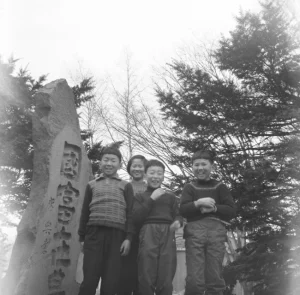
「国富在農」の碑の前で。前列左は弟、岳義さん、右は弟、正薫さん、中央は正薫さんの親友、宮本広大さん。後ろは筆者。1961年頃
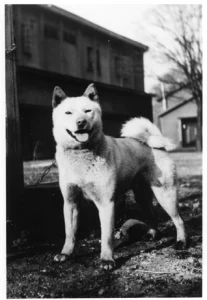
札幌での伊智狼 1964年
札幌から東京へ(1964-1972): 道犬保関東支部
北海道犬保存会(道犬保)の関東支部の会員は、東京都内だけでなく、関東の神奈川、埼玉、千葉、茨城など広域に会員がいた。東京と言っても、住んでいた雑司ヶ谷は、日本女子大や鬼子母神様の近くで、まだのどかな都会だった。3年後に家族で青山一丁目に引っ越したが、青山も時代の先端ファッションで新興し始めたころだった。道犬保関東支部長の板井一雄さんは、岩見沢系の北海道犬、王虎を大変かわいがり、誇りに思っておられた。王虎を見ると、最初の伊智狼が岩見沢系だったことがよくわかる。大型で頭部から腹部の白毛は、千歳系とはあからかに異なる特徴があった。現在、北海道犬に岩見沢系をほとんど見ないのは寂しい。歴史を遡ると、千歳系が日本の本州からの人と犬の往来に伴われたとされる一方、岩見沢系は、北方の人と犬の往来に伴われた特徴があるとされている。北海道犬は犬種のルーツを区分する遺伝子調査とその論文(1991年 岐阜大学/麻布大学 田名部雄一教授)で、琉球犬と最も近い南方犬を祖に持つとカテゴリに区分され証明されているが、この調査対象の北海道犬に、岩見沢系は含まれていない可能性が高い。北方のアラスカン・マラミュート、ハスキー、サモエドなどから溯った北方系の犬からの影響を受けた遺伝子区分になるという仮説のまま、証明されないうちに、このまま姿を消してしまう恐れがある。それでは、アイヌ文化だけではなく、北方や海を隔てた地域との多文化が往来した北海道の文化の豊かさを証明する機会を失うことになってしまうと、私は残念に思ってきた。
王虎の所有者の板井さんは、趣味の豊富な方で、特に日本でのアーチェリーの普及に尽力され、アーチェリーに関する著書も出版されていた。板井さんは、この著書のプロフィールを読むと、「米国シアトル生まれ、青山学院大学英文科卒、日産ディーゼルで主として欧米でディーゼル自動車の調査や研究に携わり、趣味がアーチェリーとアイヌ犬」、とある。
板井支部長はアーチェリーを使う欧州の狩猟での狩猟犬の役割と、熊猟で北海道犬が果たす役割の違いを、会員に聞かれて説明されたことがあったそうだ。「西洋犬は人と一緒に鹿やうさぎなどの獲物を追い込んだり、仕留められた小動物や鳥などを、人間のところまでくわえて運搬してくる役目が得意であり、北海道犬のように人間のパートナーとして、主人の意を汲んで行動し、状況を窺いながら必要であればヒグマのような大型野生動物に果敢に対峙し、対応するわけではない」と言われたと聞いて、板井支部長のアーチェリーとアイヌ犬という、趣味がつながって見えた。
From Tokyo to Sapporo, Hokkaido(1964-1972): Kanto branch of Dokenpo
The members of the Kanto branch of the Hokkaido Dog Preservation Society (Dokenpo) were not only in Tokyo, but also in a wide area such as Kanagawa, Saitama, Chiba, and Ibaraki in the Kanto region. Even though it was Tokyo, Zoshigaya, where we lived, was a peaceful town near the Japan Women’s University and the Kishibojin(shrine). Mr. Kazuo Itai, the branch manager of the Kanto branch of Dokenpo, loved his dog, Ohko and was proud of him. Ohko was an Iwamizawa type of Hokkaido dog. When I looked at Ohko I could tell that the first Ichiro was of the Iwamizawa pedigree . The large white coat from the head to the abdomen had distinctly different characteristics from the Chitose pedigree. Currently, it is sad to see almost no Iwamizawa dogs in Hokkaido dogs. The Chitose pedigree is said to have been accompanied by moving of people and dogs from Honshu, Japan, while the Iwamizawa pedegree is said to be a characteristic of moving people and dogs from the north. Chitose Hokkaido dogs have been proven by genetic research, but I have not heard that Iwamizawa dogs have. There is a risk that Iwamizawa dogs will extinct before the hypothesis is proven that they share the same genetic division as Alaskan Malamute, Husky, Samoyed, etc. which are originally form the north.
Mr. Itai, branch manager of the Kanto branch of Dokenpo and the owner of Ohko, had a lot of hobbies. One of his hobbies was western archery and he made efforts in popularizing archery in Japan and even published books on archery. According to the profile of Mr. Itai’s book, he was born in Seattle, USA and graduated from Aoyama Gakuin University with a degree in English Literature. He worked for the Nissan Diesel company and was mainly involved in surveys and research on diesel vehicles in Europe and the United States.

板井支部長は、関東支部の「アイヌ犬の姿」第3編の序文で次のように述べている
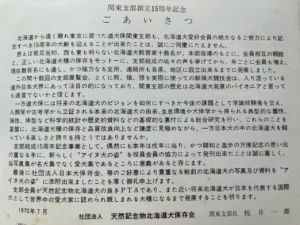
「アイヌ犬の姿」序文
「北海道から遠く離れ、東京で発展してきた道犬保関東支部は、北海道犬を愛する会員の熱心な努力によって15周年を迎えることができ、誠に喜ばしいことです。発足当時は、わずか10数名の会員が、北海道の本部と協力し合って、会員相互の親睦と正しい北海道犬の保存をモットーに集まり、年々会員数が増え、現在は数百名に達しました。東京や関東だけでなく、各県にも支所や連絡所が設立されています。10数回の関東支部展覧会、特に熊、イノシシ、狸にどのように反応するかの獣猟競技会は、北海道犬発展のパイオニア的活動といっても過言ではなく、多くの日本犬愛好家の注目の的となっています。
Mr. Itai mentioned the following in the preface of the Kanto branch publishing 「Ainu dog」. Far from Hokkaido, the Dokenpo Kanto Branch, which was established in Tokyo, is delighted to be able to celebrate its 15th anniversary with the enthusiastic efforts of members who love Hokkaido dogs. Initially, only a dozen members liaised with the headquarters in Hokkaido and gathered under the motto of mutual friendship and proper preservation of Hokkaido dogs. The number of members increased year by year, and now it has reached several hundred. Branch offices and liaisons have been established not only in Tokyo and Kanto, but also in each prefecture.
It is no exaggeration to say that the 10-odd Kanto branch exhibitions, especially the field trials on how dogs react to bears, wild boars, and raccoon dogs, are pioneering activities for the development of Hokkaido dogs. And these exhibitions have become the focus of attention for many dog lovers of Japanese native dogs.
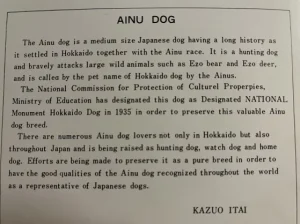
さらに、英語に堪能だった板井さんは、1970年の時点で序文を英語でも紹介している。 北海道犬の専門家が、その特徴を正確に英語で記述しているのは、これ以前の文献では見たことがない。
この中で、板井さんは、2022年現在においても、通用する的確さで、先見性を持ってアイヌ犬を紹介している。
In addition, Mr. Itai, who was familiar with English, introduced the preface in English as well in 1970. It was the first time for me to see a Hokkaido dog expert describe Hokkaido dogs in English.
In this preface, Mr. Itai introduces the Ainu dog accurately with foresight that can be used even now in 2022.
「アイヌ犬は、アイヌの人々と北海道で定住を共にした長い歴史がある。中型の日本犬で、北海道の大型の野生動物であるヒグマやエゾシカを勇敢に攻撃する狩猟犬で、北海道犬はアイヌ犬と呼ばれてきた。1935年、この貴重なアイヌ犬は、この犬種を保存するために、文部省文化庁によって、国の「天然記念物北海道犬」として指定された。現在では北海道だけではなく日本全国にアイヌ犬愛好家が、猟犬として、家族の一員として、アイヌ犬を育てている。アイヌ犬を日本犬を代表する一犬種として世界でも認められるように、現在も私たちの努力が続けられています」。
“The Ainu dog has a long history of settling in Hokkaido together with the Ainu people. It is a medium-sized Japanese dog, a hunting dog that bravely attacks large wild animals of Hokkaido such as bears and deers. And Hokkaido dogs have been called as Ainu dogs. In 1935, this precious Ainu dog was designated as the “natural monument Hokkaido dog” by the Ministry of Education, Culture, Sports, Science and Technology to preserve this breed.
Nowadays, Ainu dog lovers are raising Ainu dogs not only in Hokkaido but all over Japan as hunting dogs and as members of the family. We are still making efforts to make the Ainu dog one of the representative dog breeds in the world.”
最近まで、北海道では北海道犬を「アイヌ犬」と呼んではいけないと言うが慣例があった。道内の新聞でも、「アイヌ犬」と書くと翌日、「北海道犬」の間違いでしたというお詫びと訂正が新聞社から出るのだが、おそらく今でも続いていると思われる。アイヌ民族と犬を並べて書いてはいけない、という意味の理由だったが、アイヌの人々が、長い間差別や搾取を受けてきた歴史から遠く疎いということにして、道外の人たちは、北海道犬をアイヌ犬と呼んではいけないという北海道の行政やメディアのルールに沈黙してきたようだった。そのため、「北海道犬っていうのはアイヌ犬のことかい?」としばしば聞かれた。道民は、アイヌ犬と小さなころから馴染んできたため混乱してしまったのだ。
1935年に、アイヌ犬が、天然記念物北海道犬として認定されたのは、日本犬は原則として、秋田犬はじめ生産地の地名を名前につけるからである。柴犬は、認定前にすでに全国に普及して、生産地を指定できなかったと言われている。柴犬の血統書(登録)第一号は島根県で記録されている。弥生時代、大陸や朝鮮半島から渡来した人々とともに、日本に渡った犬として知られている。
Until recently, there was a custom in Hokkaido that Hokkaido dogs should not be called “Ainu dogs”. Even in the Hokkaido News Paper, they apologized for writing Ainu dog in their newspaper and edited the article the next day to Hokkaido dog. I presume this social trend there is still going on. The Ainu people and dogs should not be written side by side. People living outside of Hokkaido who were not or pretending to be at the scene of the history of Ainu being discriminated against and exploited in Hokkaido would not know this. Therefore, I was often asked, “Does the Hokkaido dog mean the Ainu dog?” The people of Hokkaido have been familiar with Ainu dogs since they were little, and the local government and newspapers call them Hokkaido dogs, so they were often confused.
In 1935, the Ainu dog was designated as a natural monument Hokkaido dog because, in principle, Japanese dogs are named after the place of production, including the Akita dog. Shiba Inu is an exception to this rule because it is said that the Shiba Inu had already spread nationwide before being designated and thus, could not be named after the production area. The first Shiba Inu pedigree (registration) is recorded in Shimane Prefecture. It is known as a dog that accompanied to Japan with people who came from the Continent and the Korean Peninsula during the Yayoi period. At the same time as hunting, the role is to “bark well” as a guard dog to inform when people come. Speaking of Japanese dogs, the Shiba Inu, which is much smaller than the Akita Inu, was easy to keep in Japanese households and is still very popular nationwide.
摩理(マリ)
東京で、雑司ヶ谷から青山に引っ越してまもなく、突然、伊智狼のお嫁さんにと、 北海道、釧路の林 一さんから、北海道犬の子犬が送られてきた。林さんとは面識はなかったが、これを機会に道東の釧路で、千歳系の北海道犬を普及されている方だと知った。子犬の 血統書の名前は「とっぷ」だったが、通常は「摩理(マリ)」と呼んだ。マリの血統書は、千歳系の名犬と言われた秀やジロなどが名を連ねていた。
本当は伊智狼のような白い犬には、色素を濃く保つためには白いお嫁さんより赤や黒がよいと審査員や周囲の方々から言われていた。それを承知で柿崎先生が、それでも我が家は、血統書に秀やジロの名前を見ると喜ぶと確信され、林さんと相談されたようだ。千歳系を代表する犬の名前が並ぶ血統書はたしかに素晴らしかったが、血統だけでなく、マリは利発で気品のある、いい子だった。何の前触れもなく、釧路から東京まで突然、子犬が送られて来たのには家族全員がびっくりしたが、それでもすぐに同じくらい大喜びした。
後に伊智狼とマリは、子犬を沢山つくり、東京や首都圏に飼われた子どもたちは、展覧会で再会のが楽しみだった。会員に知人が多い叔母は、伊智狼とマリの子犬たちの様子を知りたくて、お家を訪ねていけるところは会いに行った。帰ってくると 「よかった。かわいがってもらっていて」と、安堵していた。叔母は1980年に52歳になったばかりで逝ってしまったが、人間にも動物にも自分のことは譲ってでも、やさしかった。読書家で、小説や文学、スポーツ、大相撲やプロ野球にも詳しかった。いろいろなことを私に教えてくれて、自分のことより、いつも私たち家族全員のことを考えてくれていた叔母だった。
Mali
Shortly after moving from Zoshigaya to Aoyama, Tokyo, we received a surprised delivery from Kusiro, Hokkaido. It was a cute puppy of Hokkaido dog. At the same time, we had a phone call from Mr. Kakizaki in Sapporo of Dokenpo telling us that the puppy would be so nice as a partner of Ichiro. Mr. Hayashi was popularizing Chitose Hokkaido dogs in Kushiro, Eastern Hokkaido. The puppy’s pedigree was called “Top”, but she was usually called “Mali”. Mali’s pedigree included reputable Chitose dogs; Shu and Jiro.
It was customary for white dogs like Ichiro to have partners with red or black coats rather than white to keep the pigment darker when they have puppies, but the names of dogs in the pedigree representing the Chitose family were wonderful. Looking at the pedigree, the family was convinced and pleased that she was selected as his wife. Above all, Mali was clever, elegant and tender.
Even so, the whole family was very surprised to receive the sudden delivery without any previous information, but soon equally overjoyed to have a new family member.
Later, Ichiro and Mari had a lot of puppies, and when my aunt (sometimes with me ) went to dog exhibitions, she could see their grown up puppies again, who were adopted in Tokyo and the metropolitan areas. In addition, my aunt was happy to meet the puppies’ new families when she was invited. Upon her return, she would say, “I’m glad. I’m grateful for their love to the puppy.” with relief. My aunt was tender. She would always think about other people and animals interests before her own. Both my aunt and mother loved to read and were familiar with novels and literature. She was a voracious reader and knew a lot about novels, literature, sports, such as sumo and professional baseball. She taught me many things and was an aunt who always thought more about all of us family members than herself.
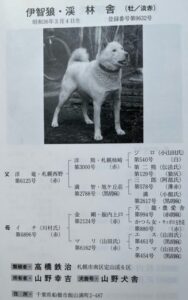

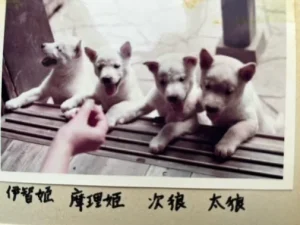
最初のマリと伊智狼の子犬は4匹生まれた。 関東だけではなく、太狼と次狼と名付けた2頭は名古屋に行くことになり、お別れの日はマリにわからないようにそっと見送り、叔母は泣いていた。それを見て私も一緒に泣いた。マリは60日ぐらいまでは、一心不乱に授乳や子育てに没頭し、父親の伊智狼が子犬をの覗きに来たり、一緒に遊ぼうとしても、そばに来るのを歓迎しなかった。
マリは伊智狼を信用していないのか、時には威嚇して追い出すのだった。伊智狼は所在なくとぼとぼと所定の自分の居所に戻って行った。子犬たちが飼い主に引き取られて離れてしまったら、マリはどうなるのか心配したのだが、一所懸命育て終わって手を離れると、やや放心状態に見えたが、わりとサバサバとして、やがて家族に甘える元のマリに戻るのだった。
関東支部の北海道犬展覧会が開催される日は、たいてい日曜日か祝日のお休みの日で、8時半には会場に到着するように、自宅を出発した。展覧会が終わると会場のお掃除や片づけをして夕方に帰宅した。伊智狼は展覧会と獣猟競技の両方で優勝していたので、伊智狼を見に来る会員もおられため、午前中から会場に行くのが普通だった。マリも一緒に展覧会に行くこともあった。マリもいつも良い成績を収めた。
Not only Kanto, but the two puppies named Taro and Jiro were adopted to families in Nagoya, and on the day of farewell, my family gently saw them off so that Mali wouldn’t notice, and my aunt was tearing. Seeing that, I cried as well. For the first 60 days after giving birth, Mali was devoted to breastfeeding, raising and protecting the puppies. Even when the puppies’ father, Ichiro went to look into them or tried to play with them, Mali did not welcome him to come by.
Perhaps, Mali didn’t trust Ichiro and sometimes threatened to kick him out. Ichiro would then go back to one of his favorite places. We were worried about what would happen to Mali if the puppies were adopted by new families, but when she finished raising them , she seemed a little exhausted and absent-minded at first, but soon returned to the old Mali we knew and loved.
The Hokkaido dog exhibitions of the Kanto branch were usually held on Sundays or national holidays, so we would leave our home early to reach the venue by 8:30. After the exhibition, we would help clean the venue and return home late evening. Since Ichiro had won both the exhibition and the beast hunting competition, it was normal to go to the venue in the morning because some members came to see Ichiro. Mali also came to the exhibitions together from time to time. Mali would also perform very well.
叔母(田原登美恵)と道犬保
叔母が一人で展覧会に行くことが増えてきて、いつも伊智狼とマリの2頭連れていくことはできなかった。両親もふだんは犬と近くを散歩し、よく犬の相手をして話しかけていた。
父の書いた本は仕事のことが書かれていると思って、よく読んだことがなかったが、父が亡くなったあと改めて父の著書を何冊か読んでみると、仕事の本のなかにも伊智狼やマリだけでなく北海道犬のことや道犬保での付き合いなど、頻繁に出てきて驚かされた。元来、犬好きの父がどんなに北海道犬に想いを寄せていたかがわかった。道犬保の顧問を長くさせて頂いていたので、道犬保の仕事も何かはやっていた様子だったが、展覧会にはなかなか来れなかった。
叔母や私に伊智狼の運動や展覧会でのハンドラーについて本格的に教えてくださったのは、札幌に住んでいた時、伊智狼の父犬、洋竜(父犬が洋熊、母犬が満智)を所有していた西野英夫さんだった。西野さんの自転車には洋竜のほかに2頭ぐらいの北海道犬が一緒に運動していた。人間にはおとなしい洋竜だが狩猟本能もすこぶる強く、数々の武勇伝があったが人前で自慢もできなかった。西野さんのおかげで、私は自転車で犬を運動させることが身について、社会人になってからも道路交通法で違反とされない時代は、自転車で2頭や3頭の犬を連れて走ることが当たり前のようにできた。西野さんは、洋熊の系列の洋竜、苫王、熊王たちをしばしば運動の途中、我が家に連れて来て遊ばせてくれた。3頭はそれぞれ伊智狼の父、叔父、弟だった。私は表情豊かな苫王が大好きで、展覧会で苫王に会うのが楽しみだった。苫王も私を見るとお腹を見せて嬉しそうにして、それが中学生の私には自慢だった。苫王は、会場で人が探して見に来るようなよく知られた犬だったが、誰でも寄せつけるということはしなかったからだ。伊智狼が丈夫で立派な犬に成長したのは、西野さんのおかげであると、家族はみんないつまでも感謝していた。
札幌で西野さんに教わった通り、叔母は関東支部の展覧会も獣猟競技でも伊智狼とマリのハンドラーは全部一人でやっていた。私はだいたい叔母と一緒に行ったが、高校1年生から大学生の時期で、日曜日はいろいろな行事も多いことも理由にしたが、日曜日の朝早くいろいろ準備して出かけるのは、本当は眠たくてできなかった。
叔母は展覧会や獣猟競技大会などの会場で、多くの北海道犬を見て、審査員や経験者からも知識を得ながら叔母自身も伊智狼やマリ、そしてその子供たちを健康で優れた犬にするために、いつも勉強していた。私も叔母から北海道犬の系統や血統書、会員の様々な考えを間接的に聞いてきたことで、北海道犬への関心を長く強く持ち続けることができた。 叔母は関東支部の会員の皆さんから信頼を得たのは当然だと思う。叔母は、いつのまにか北海道保存会関東支部の理事をボランティアで務め、家族が東京から千葉県に引っ越したときは、関東支部の千葉支所が叔母に託されて創設された。
叔母は、道犬保関東支部の理事の名刺や、関東支部千葉支所の表札を、 受け取って、一度母や私に見せてくれたが、気恥ずかしかったのか、そのまましまって、名刺も表札も実際に使った様子もなかった。叔母が一所懸命関東支部のボランティアの仕事をしていたことを、私はもっとよく理解して、手伝って、感謝すべきだったと、今でも悔やんでいる。
関東支部の会員たち
道犬保の関東支部で、王虎やその子供たちを見て、私は岩見沢系の北海道犬の特色を目のあたりにした。王虎の子供たちも立派な犬ばかりで、関東支部では、千歳系だけではなく岩見沢系の北海道犬も同等に勢いがあった。岩見沢系の北海道犬は、千歳系北海道犬より大型だった。岩見沢系の北海道犬は、ハスキーやアラスカン・マラミュートのような北方犬に見られる、顔からお腹にかけての白いコート(毛並み)がくっきりと表れる特色が共通していた。北海道犬に岩見沢系と千歳系が現存していることは知っていたが、実際に目の当たりすると、私は最初に飼った伊智狼は、厚王とともに岩見沢系だったことを改めて確信した。
岩見沢系は、千歳系とは異なる人々に伴われた犬の移動があったのではないかという仮説の側面からも興味深い。現在は北海道犬の岩見沢系は千歳系とミックスされていった過程を経て、札幌でも東京はじめ関東でも全部が千歳系の北海道犬になっているようだ。したがって王虎やその子の王竜のような、岩見沢系北海道犬の写真は貴重だ。
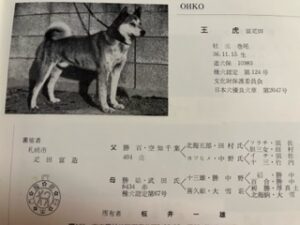

My aunt Tahara Tomie
My aunt started going to the exhibitions by herself more and more, but she couldn’t always bring both Ichiro and Mali.
On Sundays, my dad usually went to work-related meetings and played golf. My mother had to stay home. Therefore, my aunt went to the exhibitions, and also became the handler. I usually went with them but couldn’t go when I was in the first grade of high school to college, as there were many events on Sundays, but the truth is that I was really sleepy to get ready and go out early on Sunday mornings. My aunt took care of daily walks with Ichiro and Mali, exhibitions, and field trials for our family whenever necessary.
My aunt saw many Hokkaido dogs at exhibitions and field trials , and while gaining knowledge from judges and experts, my aunt himself made Ichiro, Mali, and their puppies healthy and excellent. By indirectly hearing from my aunt about the lineage, pedigree, and various ideas of the members, I was able to maintain a strong interest in Hokkaido dogs for a long time. My aunt was a director of volunteers for the Kanto Branch of the Hokkaido Preservation Society, and when my family moved from Tokyo to Chiba Prefecture, the Chiba substation of the Kanto Branch was entrusted to my aunt. I think it was natural that my aunt gained the trust from the members of the Kanto branch.
My aunt received the business card of the director of the Kanto branch of Do Ken Po and the nameplate of the Chiba substation of the Kanto branch. She showed them to our families, but maybe it was embarrassing, she left those as they were, and the business card and nameplate were actually It didn’t seem to be used for. I still regret that I should have better understood, helped, and thanked my aunt for working hard as a volunteer in the Kanto branch.
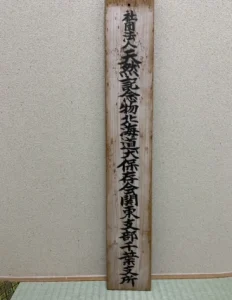
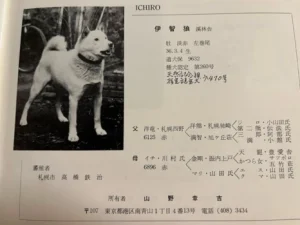
Members of Kanto branch
At the Kanto branch of the Dokenpo, I saw Ohko (picture above right) and his puppies. I also witnessed the characteristics of the Iwamizawa Hokkaido dog. Ohko’s puppies were all splendid, and for a while the Kanto branch had a lot of Iwamizawa-type Hokkaido dogs. Hokkaido dogs of the Iwamizawa type were larger than the Chitose type. The Iwamizawa type Hokkaido dogs had a common characteristic of a distinct white coat from the face to the belly, similar to northern dogs such as huskies and Alaskan malamutes. After learning about different types of Hokkaido dogs, I found out that Atsuo (father of the first Ichiro) and our first Ichiro were of the Iwamizawa-type.
If the hypothesis that the Iwamizawa lineage has the appearance and characteristics of northern dogs is confirmed, it is thought that the the diverse ethnic groups that traveled to and from Hokkaido will also be clarified from the perspective of the movement of dogs accompanied by people. Currently, the Iwamizawa type of Hokkaido dog has gone through the process of being mixed with the Chitose type, and it seems that all of the Hokkaido dogs in Sapporo, Tokyo, and the Kanto region are Chitose type Hokkaido dogs. Therefore, photographs of Iwamizawa-type Hokkaido dogs, such as Ohko and the Ohryu of Ohko’s son are valuable.
遠山家の桜姫
東京目黒区の遠山家に、伊智狼の子犬(桜姫)がもらわれていったことで、遠山冨士江夫人と再会した。北海道の町村知事と二葉夫人の長子が遠山冨士江さんで、末のお子さんが政治家にならなれた故・町村信孝氏である。冨士江夫人は、知り合いになるとみんな大好きになるようなとても明るく、聡明で優しい方だった。遠山さんのお宅は家族全員が大変な愛犬家で、桜姫は病気もしないで、展覧会や獣猟競技にも出陳してもらい、当時は長寿の13歳だった。遠山さんはだいぶ時がたってから、やはり北海道犬が忘れられず、札幌の方に北海道犬の子犬をお世話してもらって、その後また飼いました、とお手紙をいただいた。
道犬保には、遠山さんという苗字で、もう一方、遠山景久氏がおられた。冨士江夫人の夫君とよく似たお名前でお二人とも著名だったので、みんなよく取り違えた。景久氏は「ヨーロッパケチョンケチョン」というご本を出版されていたので、「ケチョンケチョン」と道犬保仲間では親しまれていた。犬舎名はご自分が経営されていたレストラン「アラスカ」からとって「アラスカ荘」だった。子犬が産まれたら道犬保に犬舎名も届け出るので、我が家でも伊智狼とマリの犬舎名は「山野犬舎」と両親と叔母が決めたようだ。立派な名前で、とても気に入った。
Ever since Ichiro’s puppy (Sakurahime=princess Sakura) was given to the Touyama family in Meguro-ku, Tokyo, my mother and aunt became close with Mrs. Fujie Touyama, mainly chatting about Hokkaido dogs. She was the eldest child of governor & Mrs. Machimura in Hokkaido, and the youngest son was the late Nobutaka Machimura, who became a politician. Mrs. Touyama was such a bright, intelligent and tender person that everyone who got to know her loved her. In the Toyama family, Sakurahime was called “Koro” and was loved very much. Everyone in the Touyama family was a big dog lover, and I think Sakurahime was the happiest dog I’ve ever known. Koro died at the age of 13, which was a long life at the time, and did not get sick.
In DoKenPo, there were two people with the surname Touyama. One was Mrs. Fujie Touyama’s husband, and the other was Mr. Kagehisa Touyama. They were both well- known, and people often got them mixed up. Mr. Kagehisa Touyama published books titled, “Europe Kechon Kechon”. As such, his nickname was “Kechon Kechon” among his DoKenPo friends. The name of the kennel was “Alaska-so” after the restaurant “Alaska” that he managed. When the puppies are born, we will report the kennel name to the DoKenPo, so it seems that my parents and aunt decided that Ichiro and Mari’s kennel would be named “Yamano Kennel” It’s a great name and I really like it.
北村さださんと東光
北村さださんは、東光という、赤(茶)の素晴らしい犬を所有していた。マリが我が家に来る前は東光は伊智狼との間に、可愛い子犬を3回出産した。北村さんの東光は、バランスのとれた優しい性格の犬で、展覧会では常に牝のトップだった。北村さださんは、村瀬幸子という名前の、よく知られた俳優座の舞台女優で、舞台だけでなく、映画やテレビドラマにも出演されていた。北村さんは、犬の展覧会場に東光とよく来られて、展覧会終了時の片づけやお掃除まで済ませて帰宅された。北村さんと、私の両親と叔母は、犬と演劇の話で、みんな忙しい中でもとても楽しそうに時間を過ごしていた。私たち家族も村瀬さんがお芝居に出演されるときは、村瀬さんから切符を買って、六本木の俳優座劇場まで観に行った。同じく俳優座の栗原小巻さんが、テレビの大河ドラマに出演したのを機に人気絶頂の頃だった。
Ms.Sada Kitamura had a wonderful red (brown) dog named Tonko. Before Mari came to our house, Tonko gave birth to cute puppies three times with Ichiro.
Sada Kitamura often came to the dog exhibition hall with Tonko, and after finishing the exhibition and cleaning up , she returned home. Tonko was an excellent balanced and tender dog, always winning the top prize in the female group. Ms. Sada Kitamura, had an alias named Sachiko Murase. She was a well-known stage actress at the Haiyuza Theater, and had appeared in films and TV dramas.
Sada Kitamura, my parents and aunt got to know each other through Tonko and Ichiro, and while they were all busy, they seemed to enjoy spending time talking about dogs and theater.Whenever Sachiko Murase appeared in a play, our family bought tickets from her and went to see it at the Haiyuza Theater in Roppongi. At that time, Ms. Komaki Kurihara, also a member of Haiyuza, was enjoying most of her popularity when she appeared in a NHK-TV Taiga drama (long running NHK-TV series) .
板井支部長とのお別れ
1972年1月10日に、板井一雄関東支部長が亡くなられた。王虎は何も食べなくなりお葬式の日は、悲しい遠吠えを繰り返し、参列者は板井さんと王虎の愛情の深さに胸を打たれたと伝えられている。私の父もお葬式に参列し、父はその日の王虎を二首、歌に詠んでいる。
Farewell to Branch Manager Kazuo Itai
On January 10, 1972, Kanto Branch Manager Kazuo Itai passed away at age of 59. Ohko, his beloved dog, stopped eating and on the day of his funeral, he repeatedly howled sadly. My father also attended the funeral, and he composed two tanka (Japanese short poems) about Ohko that day.
板井一雄氏(天然記念物北海道犬保存会関東支部長)の葬送の日に贈る。
Poem shared on the day of the funeral of Mr. Kazuo Itai (Natural Monument Hokkaido Dog Preservation Society Kanto Branch Manager).
君をおくる みぞれ降る日に 「王虎」鳴くなり
We send you on a sleet day, while your Ohko mourns.
遠吠えの王虎は悲し 主なき雪つもる夜を 寝もやらずして
The howling Ohko is sorrowful, without even sleeping on a snowy night, missing you.
結び 一般社団法人天然記念物北海道犬保存会(道犬保)の本部展を観ながら想う(2022.10.16)。
DoKenPo’s latest Headquarters exhibition (2022/10/16)
北海道犬を愛した両親も叔母も、すでに亡くなり、伊智狼もマリも一緒に住んでいた自宅の庭で永眠している。私は今、犬はいないが、関東支部で佐竹博支部長のころまでは、展覧会や会合に参加させていただき、現在も厚かましく会員に留まっている。道犬保の北海道犬の写真集や冊子、血統図などは見ていて思い出だけでなく啓発される。書かれている内容も研究者やアカデミアを超えて充実して洞察に富むものだといつも感心している。私が知っている北海道犬は、我が家の愛犬とその周囲だけであるから、私は機会があれば、いろいろな方の北海道犬の話を聞くのが大好きで、それを半世紀ぐらい続けてきたように思う。
2022年10月16日(日)には札幌市北区屯田公園で開催された本部展覧会・獣猟競技会を見に行き、展覧会に間に合った。関東ではなかなか集まる機会がない北海道犬が、続々と100頭前後出陳され、所有者や家族がハンドラーとして登場した。本部展では高いレベルで競われながら、道犬保のアマチュアリズムも味わえた。北海道犬そのものは衰退していないどころか、北海道の自然の厳しさの中で脈々と受け継がれた精悍さと素朴さを感じさせる北海道犬をみることができて、本部展の出陳犬の層の厚さには感嘆した。
西谷内透美男審査委員長はじめ審査員の丁寧な講評があり、講評は道犬保では重要視され忠実に受け継がれていると感じて嬉しかった。道犬保は組織の継続性の根拠になる北海道犬はどうあるべきか、それはなぜか、という関係者が書かれた記録が豊富だと思う。審査員が述べる所感やコメントは、総合的な北海道犬のあるべき姿とともに、実際に日々世話をしている所有者や家族へ向けて役立つ助言が添えられてきた。理論と実践を具体的に実行してきた道犬保は、これからも様々な立場や視点を持つ会員が、これまでどおり、北海道犬を家族として愛し、併せてよい犬を存続させていく伝統とともに、さらに発展していただきたいと願っています。
上掲は一般社団法人天然記念物北海道犬保存会会報 2023年2月号に掲載された原稿です。
The article was published in the February 2023 issue of the Bulletin, the Society for the Preservation of the Natural treasure of Hokkaido Dog.
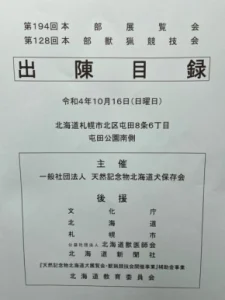
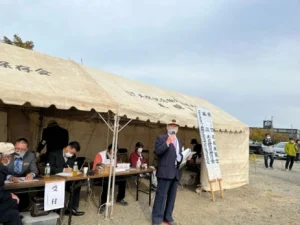


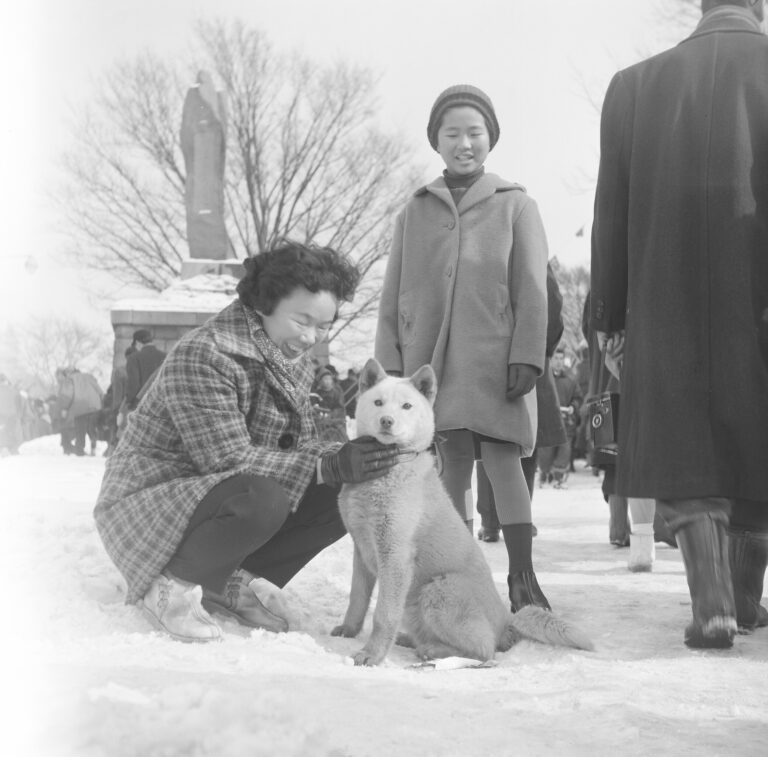


コメント